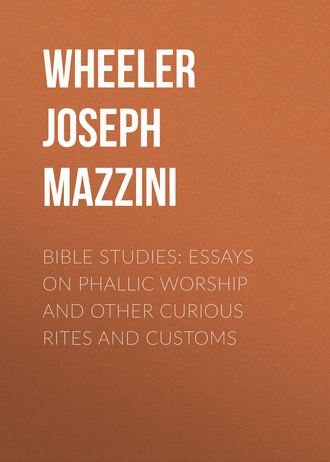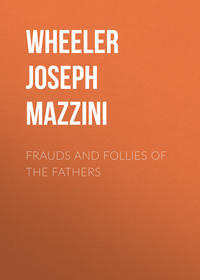 полная версия
полная версияBible Studies: Essays on Phallic Worship and Other Curious Rites and Customs
Section 7 of the Kabbalistic Sepher Yezirah58 says, "The seven planets in the world are Saturn, Jupiter, Mars, Sun, Venus, Mercury, Moon. Seven days in the year are the seven days of the week; seven gates in man, male and female, are two eyes, two ears, two nostrils and the mouth." Again, section 15 says, "By the seven double consonants were also designed seven worlds, seven heavens, seven lands, seven seas, seven rivers, seven deserts, seven days a week, seven weeks from Passover to Pentecost, there is a cycle of seven years, the seventh is the release year, and after seven release years is jubilee. Hence God loves the number seven under the whole heaven."
The Bible, it has been remarked, begins in Genesis with a seven, and ends in the Apocalypse with a series of sevens. God himself took a rest on the seventh day and was refreshed, or, as the Hebrew reads, took breath. The Passover and other festivals lasted seven days; Jacob bowed seven times; Solomon's temple was seven years in building; the tabernacle had seven lamps, a candlestick with seven arms, etc. In a variety of passages it seems, like 40, to have been a sort of round number—as people sometimes say a dozen for an indeterminate quantity. Thus in Daniel iii. 19 the fiery furnace was to be heated seven times more than it was wont to be heated. In Proverbs (xxiv. 16) we are told a just man falleth seven times and rises up again. One of the Psalmists says (cix. 164), "Seven times a day do I praise thee because of thy righteous judgments" (see too Lev. xxvi. 18, 28; Dent, xxviii. 7, 35; Job ix; Psalm xii. 6, lxxix. 12; Isaiah iv. 1, xi. 15, xxx. 26; Jer. xv. 9, Matt. xii. 45). The week induced reckoning by sevens, and led to such enactments as that the Jews on the seventh day of the seventh month should feast seven days and remain seven days in tents.
The root idea of the number is that of religious periodicity. We find it not only in the Sabbath, but in all other sacred periods. Thus the seventh month is ushered in by the Feast of Trumpets, and signalised by the celebration of the Feast of Tabernacles and Yom Kippur. Seven weeks is the interval between Passover and Pentecost. The seventh is the Sabbatical year, when bondsmen were to be released and debts go free. With this custom is connected the binding of youths for seven years apprenticeship, and of punishing incorrigible offenders for 7, 14, or 21 years. The year succeeding seven times seven is the Jubilee. The earliest form, that of the menstrual period, is shown in the duration of various kinds of legal uncleanness, as after childbirth, after contact with a corpse, etc. So we have the sprinkling of the house seven times with the water of purification (Lev. xiv. 51), the command of Elisha to Naaman to wash in Jordan seven times (2 Kings v. 10). Hezekiah, in cleansing the temple, offered seven bullocks, seven rams, and seven he-goats for a sin offering. Septuple actions and agents abound. Thus the blood of sacrifices were sprinkled seven times (Lev. iv. 6, 17; xiv. 7, 16, 27; xvi. 14, 15). So Jacob bowed to his brother Esau seven times (Gen. xxxiii. 3). Balak built for Balaam seven altars, and prepares seven oxen and seven rams (Num. xxiii. 1, 4, 14, 29), and Abraham employed seven victims for sacrifice (Gen. xxi. 28, 30). We are reminded of the lines in Virgil's Æneid (vi. 58).
Seven bullocks, yet unyoked, for Phoebus choose,And for Diana, seven unspotted ewes.The Hebrew verb Shaba, to swear, is evidently derived from Sheba seven, and denoted a sevenfold affirmation. Herodotus (xiii. 8), tells us the manner of swearing among the ancient Arabians included smearing seven stones with blood. Sheba is allied to the Egyptian Seb-ti (5-2), the Zend Hapta, Greek Epta, Latin septem. The Pythagoreans said that Heptad came from the Greek Sebo to venerate, but Egyptian and other African dialects suffice to prove it is far earlier.
The writer of the Apocalypse had the mystic number on the brain. Dr. Milligan has explained the 666 number of the beast, as a fall below the sacred seven John of Patmos gives us seven golden candlesticks, (i. 1), seven stars (i. 20), seven spirits and churches (iii. 1), seven seals (v. 1), trumpets (viii. 2), thunders (x. 34), vials (xvi. 1), and seven angels with seven plagues (xvi.) The beast has seven heads, horns and crowns (xii. 3, xiii. 1, xvii. 7). The Lamb with seven horns and seven eyes (v. 1 ). There are seven spirits before the throne of God (Rev. i. 4, etc.) like the seven Dhyani Chohans emanating from Parabrahm in Hindu Theosophy.
So Christians have kept up legends of seven wise men, seven wonders of the world, seven champions of Christendom, seven cardinal virtues, seven deadly sins, seven devils in Mary Magdalene, etc. Of course there is no better reason why there should be seven than the old idea of mystery and completion attached to the number.
Modern Theosophists, too, go in largely for the number seven. There are seven planets, seven rounds on each planet and seven races. Every ego is composed of seven principles—Atma, Buddhi, Manas, Kamarupa, Linga Sharira, Prana, and Sthula Sharira. It may seem strange that a lady of Madame Blavatsky's undoubted powers of imagination should run in the old rut. But the well-worn superstitions work the easiest, although to every instructed person this one carries the mind back to the days when men knew only of seven planets and measured their time by the moon.
1
The Contemporary Review for June 1888, says (p. 804) "when Lord Dalhousie passed an Act intended to repress obscenity (in India), a special clause in it exempted all temples and religious emblems from its operation."
2
See Gougenot des Mousseaux's curious work Dieu et les Dieux, Paris, 1854. When the Luxor monument was erected in Rome, Pope Sixtus V. deliberately exorcised the devils out of possession of it.
3
"Apology for Smectymnus," Works, p.84.
4
So Baaljadah [1 Chron. xiv. 7] is Eliada [2 Sam. v. 161.] In 1 Chron. xii. 6, we have the curious combination, Baaljah, i.e. Baal is Jah, as the name of one of David's heroes.
5
The "Baal" was afterwards taken out of all such names of places, and instead of Baal Peor, Baal Meon, Baal Tamar, Baal Shalisha, etc., we find Beth Peor, Beth Meon, Beth Tamar, etc.
6
Verse vii. says, "he brake down the houses of the sodomites that were by the house of the Lord, where the women wove hangings for the grove." A reference to the Revised Version shows that it was "in the house of the Lord, where the women wove hangings [or tents] for the Asherah." See also Ezek. xvi. 16.
7
Asher was the tutelary god of Assyria. His emblem was the winged circle.
8
Symposiacs, bk. iv., queat. 6, p. 310, vol. iii., Plutarch's Morals, 1870.
9
Leviticus, p. 364.
10
That even more shameful practices were once common is evident from the narratives in Genesis xix. and Judges xix.
11
Religion of Israel chap. ix., p. 71.
12
Larousse, in his Grande Dictionnaire Universelle, says: "Le phallos hébraique fut pedant neuf cent ans le rival souvent victorieux de Jéhovah."
13
Encyclopaedia Britannica, article "Circumcision."
14
What Tacitus says is, "They do not eat with strangers or make marriages with them, and this nation, otherwise most prone to debauchery, abstains from all strange women. They have introduced circumcision in order to distinguish themselves thereby."
15
See Myths in Medicine and Old Time Doctors, by Alfred C. Garratt, M.D.
16
Journal Anthropological Institute, February, 1881.
17
Gregor, Folk-lore of North-East Counties, p. 40.
18
See the paper on "Moly and Mandragora," in A. Lang's Custom and Myth; 1884.
19
Notice too 1 Tim. 15, where women are said to be saved by child birth, their curse.
20
Encyclopedia Britannica, article "Magic."
21
Religion of the Semites, p. 142.
22
Adair, History of the American Indians, p. 162.
23
Eurip. Alcest, 100.
24
Virgil Æn., vi. 221; Tacit. Annal., 162.
25
Manu, y. 59, 62, 74-79.
26
Vendid iii. 25-27.
(v) Lucian Dea Syr., 523
(v*) J. Gk Frazer, Golden Bough, vol. i., p. 169.
27
E. B. Guthrie, Old Scottish Customs, p. 149. Charles Rogers, Social Life in Scotland, iii. 218.
28
Golden Bough, vol. i., p. 171.
29
Shortland's Southern Districts of New Zealand, p. 293.
30
Leviticus, pt. ii., p. 187.
31
Smith's Bible Dictionary, article "Blood."
32
The origin of the mystery of the Rosy Gross may have been in the savage rite of initiation by baptism with arms outstretched in a cruciform pool of blood. See Nimrod, vol. ii.
33
Azazel appears to mean the goat god. The goat, like some other animals, seems to have had a sacred character among the Jews. (See Ex. xxiii. 19, Lev. ix. 3-15, x. 16, xvii. 17, Jud. vi. 19, xiii. 15, 1 Sam. xix 18-16, 2 Chron. xi. 15.)
34
Golden Bough, vol. ii., p. 206.
35
Genuine Letters and Memoirs Relating to the Isle of Cape Breton. By T. Pichon. 1760.
36
In like manner Maimonides, the great Jewish commentator, said that innocent women would give all they had to escape it, and reckoned death preferable (Moreh Nevochim, pt. iii., ch. xlix.)
37
Journal, May 25, 1768, p. 308? vol. iii., Works, 1856. The earlier volumes of the Methodist Magazine abound with tales of diabolical possession.
38
Note on Butler's Hudibras, part ii., canto 8, line 143.
39
See The Darker Superstitions of Scotland, by Sir John Graham Dalyell, chap. xviii. Glasgow, 1835.
40
History of the Rise and Influence of Rationalism in Europe, vol. i., p. 144.
41
Colloquia de Fascinationibus.
42
Among my Books, p. 128. Macmillan, 1870.
43
The seventeenth verse stupidly reads, "The Lord hath done to him as he spake by me." The LXX and Vulgate more sensibly reads to thee.
44
To "eat the fat" seems, as in Neh. viii. 10, to have been a biblical expression for good living.
45
Religion of the Semites, p. 207.
46
Why is the ass only mentioned besides man? One cannot but suspect that his introduction is an interpolation by the reformed Jews, who had outgrown the custom of human sacrifice, betrayed by the phrase "thou shalt break his neck."
47
Nineteenth Century, April, 1886.
48
Observe that Elohim, the old gods, claim the sacrifice and Jahveh, the new Lord, prevents it.
49
It may help us to understand how the sacrifice of an animal may atone for human life, if we notice how in South Africa a Zulu will redeem a lost child from the finder by a bullock.
50
January, 1884.
51
The Golden Bough, vol. i., pp. 24, 25.
52
See too Isaiah lvi. 11-12; Jer. xxvii. 10-15, xxix. 8-9; Micah iii 5-7.
53
The Patriarchal Theory, p. 43; 1885.
54
Ibid, p. 45.
55
See Rimini's History of the Moravians and Southey's Life of Wesley vol. i. pp. 188, 387.
56
Revised Version. The Authorised Version changes the whole purpose of the piece by reading "that ye stir not up nor awaken my love till he please."
57
Natural Genesis, ii., 219.
58
Trans, by Dr. I. Kalisch, pp. 27 and 81.



